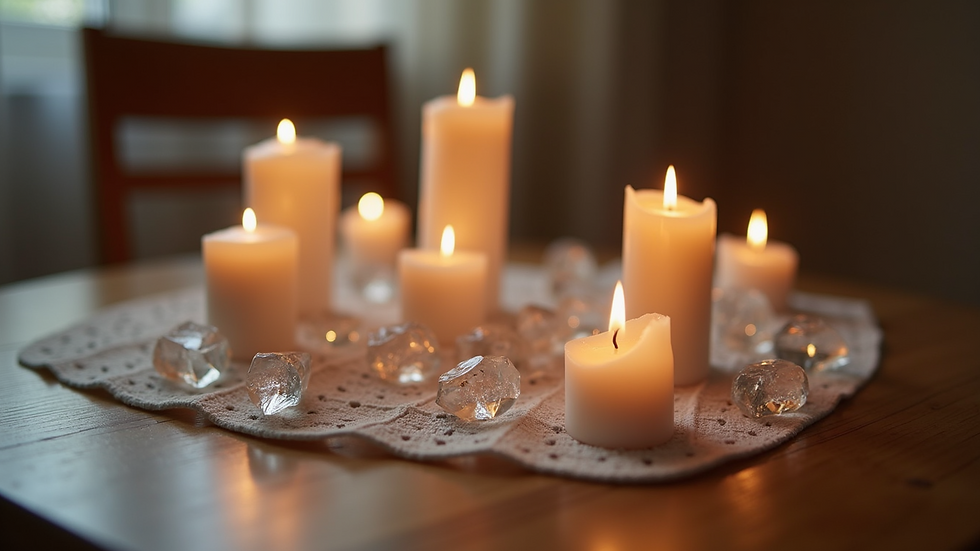Hey, Did You Know? The Untold Story of Witchcraft: A Beginner's Guide
- Janine Kinnersley-Crocker
- Jun 16
- 4 min read
Witchcraft is often portrayed in popular culture as a realm of bubbling cauldrons, mysterious incantations, and cloaked figures lurking in moonlit woods. However, the reality is much deeper and more nuanced. Its history is woven into human beliefs, societal shifts, and changing perspectives on the mystical.
In this beginner's guide, we will uncover some of the captivating aspects of witchcraft's history, examining its roots, its portrayal across time, and the myths that persist today.
The Origins of Witchcraft
Witchcraft's origins are immensely ancient. Early societies respected those believed to have special abilities, including healers, shamans, and wise women. These individuals utilized herbs, rituals, and spiritual practices to assist their communities. For instance, in Ancient Egypt, practitioners utilized plants like chamomile and myrrh for healing purposes, laying the groundwork for herbalism as we know it today.
The term "witch" comes from the Old English word "wicce," indicating a female magic practitioner. Interestingly, witchcraft was not always linked to evil intentions. In several cultures, those labeled as witches were often seen as beneficial figures who maintained community balance. For example, the village healer in many Native American tribes was revered rather than feared.
Modern witchcraft, especially Wicca, took shape in the mid-20th century, drawing heavily from ancient traditions. This revival emphasizes nature-based spirituality and rituals, celebrating the divine feminine. As a result, the image of witches has shifted from sinister figures to empowered individuals, with Wicca currently boasting an estimated 1.5 million practitioners across the globe.
Witch Hunts and Persecutions
As we move to the late Middle Ages and the Renaissance, the narrative surrounding witchcraft turned grim. The notorious witch hunts, fueled by fear and religious zeal, claimed the lives of thousands. Most of the accused were women who faced harrowing interrogations, torture, and execution.
The Malleus Maleficarum, published in 1487, played a significant role in inciting witch hunts by detailing how to identify and prosecute witches. Between 1450 and 1750, estimates suggest that around 100,000 individuals were tried for witchcraft in Europe, with about 40,000 to 60,000 executed. This horrifying period was marked by trials that frequently relied on flimsy evidence or mere hearsay.
With the onset of the Enlightenment, society began to scrutinize the legitimacy of these witch hunts, leading to a decline in trials and a reevaluation of witchcraft itself. By the 18th century, many individuals started to perceive witchcraft through a more rational lens, contributing to a cultural shift away from persecution.
The Role of Folklore and Mythology
Folklore and mythology have profoundly impacted perceptions of witchcraft. Local legends often portrayed witches in various lights. In England, the "cunning folk" were individuals believed to possess healing and magical abilities and were often sought out for their wisdom.
A compelling example from Slavic folklore is Baba Yaga, a witch character who embodies both benevolence and malevolence. Her duality showcases how witches can represent societal values and fears while also highlighting cultural interpretations of the supernatural.
As societies advanced, many of these traditional stories morphed into children's tales or horror narratives, stripping them of their original significance. The portrayal of the "wicked witch" became a common trope in literature and films, solidifying the public's view of witches as malevolent figures.

Witches in Modern Culture
Today, witchcraft is experiencing a renaissance, especially with the rise of the internet. Interest in practices like Wicca and other neopagan paths has surged. Studies show that around 1.3 million Americans identify as Wiccan. Books, workshops, and online communities have flourished, creating a vibrant network of support and acceptance among practitioners.
Popular media has significantly shaped perceptions of witches through shows like Charmed and films such as The Witch. These depictions often swing between portraying witches as awe-inspiring mystical beings and as misunderstood individuals striving for justice.
Feminism has also significantly influenced modern witchcraft, with many practitioners viewing it as a path to empowerment. By reclaiming the narrative of the witch, these individuals celebrate their experiences as forms of resistance against patriarchal oppression.
Common Misconceptions
Numerous misconceptions about witchcraft endure today. One of the most common myths is that witchcraft equates with devil worship or malevolent practices. In truth, many witches focus on nature, healing, and positive energy. Research shows that around 67% of those involved in witchcraft think of it as a practice that promotes healing and self-growth.
Additionally, the glamorized views of witchcraft in popular media often obscure its rich and varied history. For many practitioners, witchcraft is about personal empowerment, connecting with nature, and using one's energies for positive outcomes.
Recognizing these distinctions is vital for breaking down stereotypes and presenting a more accurate depiction of witchcraft in today’s society.
The Big Picture of Witchcraft
Witchcraft is far more than sensational stories and eerie symbols. It weaves a tapestry rich with history, folklore, and spiritual practices that have evolved significantly. As we've explored in this beginner's guide, the journey of witchcraft encompasses both light and shadow, reflecting how people have sought to understand their existence and place in the world.
Whether you're intrigued by witchcraft’s history, interested in spiritual practices, or simply curious about these ancient traditions, it's essential to approach the subject with an open mind. Investigating the untold stories of witchcraft allows us to appreciate its complexities and the individuals who have contributed to its legacy.

In conclusion, witchcraft is not merely about casting spells or brewing potions. Instead, it is about forging a connection with the natural world, understanding oneself, and embracing a mystical journey through life. Are you curious to learn more about the fascinating world of witchcraft? Explore further and discover what intrigues you!






Comments